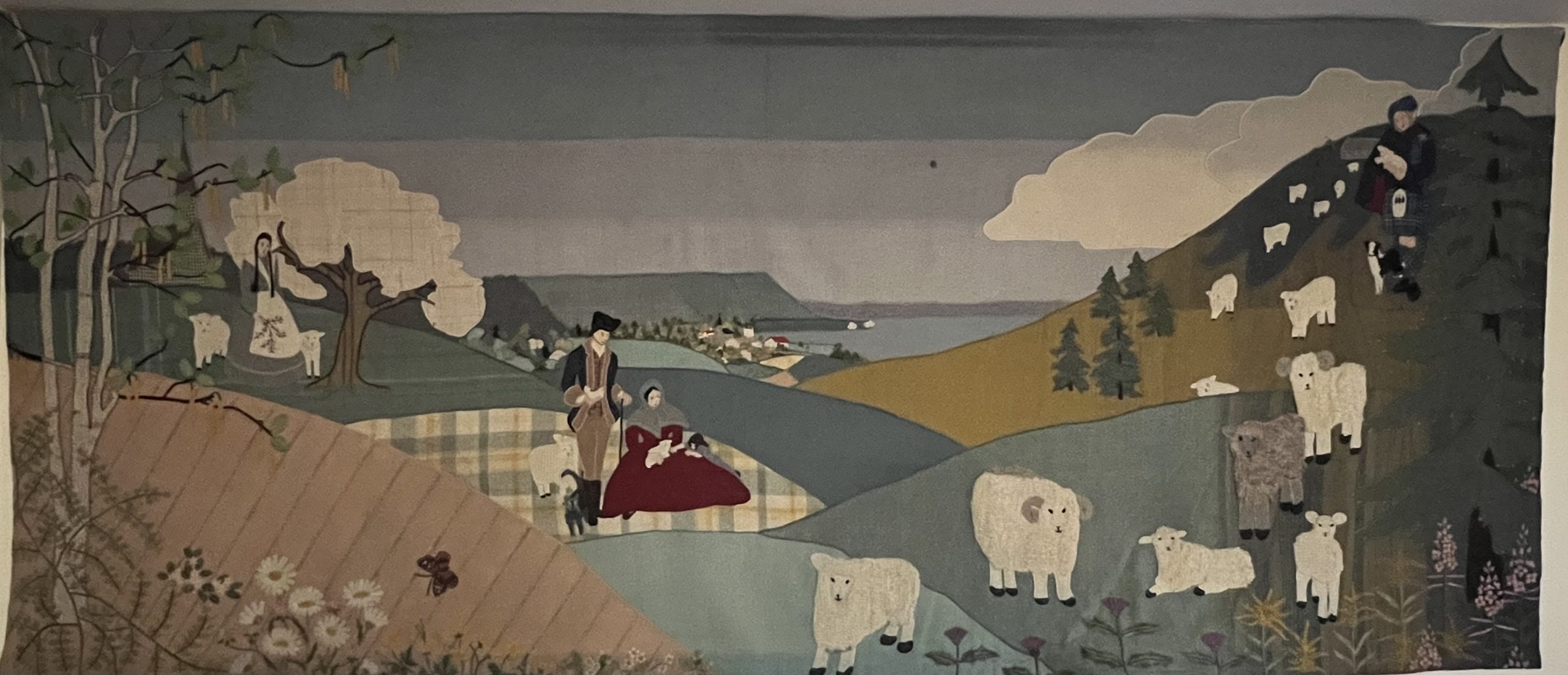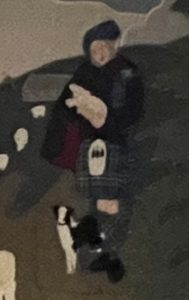Nova Scotia Wool Mural (1953)
by Hilary Doda

Mythmaking is the core of popular history, and Canada’s colonial past lends itself well to stories of bucolic rural life. A woolen appliqué mural made in the mid-20th century in Nova Scotia sets a stereotypical scene, depicting three seasons of Nova Scotian life during the colonial period. On the left, an Acadian girl stands beneath an apple tree in springtime, surrounded by lambs. In the centre, United Empire Loyalists picnic in a quiet summer field, their village framed against the mountains. On the right, for autumn, a lone Scotsman tends a flock of sheep in the Cape Breton hills.
19th- and 20th-century depictions of Nova Scotia’s founding cultures tend to focus on particular communities: the Acadians, the English, the Scots, and occasionally the Germans. However, this view omits the Mi’kmaq resident in the region for more than 11,000 years, and the Black Empire Loyalists who arrived between 1782–1785 following the American Revolution.[1] The mural depicts, and encourages remembrance of, Nova Scotia’s past as an all-white, European history. Leaving people of colour out of the image of the founding nations perpetuates the racism embedded in the way we tell the Canadian story. The viewer is invited to identify with one of the depicted demographics, and anyone from a non-white background becomes a racialized outsider—by being non-white, they are explicitly excluded from the idea of being “Nova Scotian.”
This composite fabric image tells a historical tale on the surface, a fiction of peaceful immigration and colonization that stands in contrast to the region’s actual history of deportation, war, and genocide. But spun into its hand-woven threads are multiple stories about Nova Scotia, its people, and perceptions of history. And entirely unintentionally, this large textile mural, a work of art originally designed to encourage interest in the many uses of homespun wool, helped change the public face of Nova Scotia.
The appliqué mural
In 1953, at the invitation of the Nova Scotia Sheep Breeders’ Association, Mary Black, then-chair of the Handcrafts Division of the Department of Trade and Industry of Nova Scotia, organized a display in Truro, Nova Scotia, of articles made of homespun wool. Black was also asked to arrange for a piece of textile art to become the backdrop for a display, a piece that would teach the history of sheep raising in Nova Scotia and showcase homespun wool. She commissioned Bessie Bailey Murray to design an appliqué mural made from Nova Scotian wool. The intent was twofold: to represent the history and character of Nova Scotia, and to encourage local women to work with homegrown wool rather than store-bought textiles.
Originally commissioned as a “small panel,” the mural evolved during the design process. Pieced together from over fifty different pieces of fabric in a variety of colours and weave patterns, including work from local weavers Joyce Chown and Vera Cummings, it grew to a finished size of eight feet high and fourteen feet long. The range of styles and colours represented the potential of wool as a versatile medium in a decade where artificial fibres like nylon were gaining ground and sheep farming was in major decline. The textured wools and the antiquated costumes on the figures drew the viewer back in time to a “simpler” lifestyle espoused by antimodernists, one which celebrated a very specific narrative of Nova Scotia’s past.
The tartan-clad shepherd in the upper right-hand corner refines that narrative myth even further. He is also the primary reason the mural has been preserved as historically important, as the mural contains the first example of the now-ubiquitous Nova Scotia tartan. A mainstay of Nova Scotia tourism advertising, the tartan cemented the later twentieth-century branding of the province as a primarily Scottish region. The “wee Scotsman” was intended to represent all Scottish settlers in the province, but during the design process Murray became concerned about how he should be dressed. Many Scottish families who had migrated to Nova Scotia remained attached to clan identities and old rivalries, so rather than be seen to favour one clan over another, Murray and tartan expert Isabel MacAulay designed a new, original plaid for the kilt in the mural. Based on the colours of Terence Bay, the blue, green, white, and gold tartan’s popularity exploded following the exhibition. Two years later it was formally designated the official tartan of Nova Scotia, thousands of yards of it were ordered, and the mural itself became a part of Nova Scotia’s public memory and myth-making.[2]

The fictions of place and memory
The vision of Nova Scotia encouraged by the mural’s design fits the narrative of Nova Scotia popular in the mid-twentieth century. It was created in the wake of what historian Ian Mackay has termed the “tartanism” of the province: a commercialized obsession with placing Scottish culture at the root of Nova Scotia’s settler heritage, at the expense of the diversity of the rest of the population’s lived experiences and identities. Governmental efforts—including the hiring of a bagpiper clad in Nova Scotia tartan to play at the provincial border—ensured, however, that the tartan, and Scottish culture in general, would become major parts of Nova Scotia’s national and international image.[3]
Thanks in large part to those marketing efforts, tartan itself has since become known as the traditional weaving style of Nova Scotia.[4] The style replaced other techniques from both Indigenous and settler groups which were more commonly used in the region prior to the 1950s. With Scottish culture elevated above all others, and the story of Cape Breton redesigned as a time-locked Gaelic island, tourist interest in the region boomed. The wee Scotsman and his sheep became a mascot for an imagined homeland, a declaration of Nova Scotian identity based on a constructed concept of a common past. The Scottish story eclipsed all others, flattening any diversity into a single narrative.
The stated intent of the Nova Scotia Sheep Breeders’ Association was to increase awareness of a local commodity that was losing ground in the midcentury marketplace. Antimodernist sentiment in the midcentury made the handicraft marketplace appealing, and, as crafts like hooked rugs from Chéticamp were popular with tourists, the provincial government encouraged and financially supported the production of other types of folk-art souvenirs through the Nova Scotia Department of Trade and Industry.[5] The sale of woven items like potholders and placemats was seen as a potential income stream for the wives and daughters of fishermen, who were encouraged to take courses from the Handcrafts Division. The mural itself was commercial, made through craft skills including spinning, dyeing, and weaving, yet the result was an iconic piece of art. Attempts to revitalize weaving in the twentieth century primarily focused on its artistic potential, often with a folksy aesthetic.[6] The mural’s imagery fits that nostalgic aesthetic, harkening back to a romanticized ideal of settler history.
The mural expresses some widely-held but fictitious ideas about Canada’s history, and about Nova Scotia’s cultural past. The designers’ use of a wide range of textile weaves, colours, and textures brings the image to almost three-dimensional life. The stories embedded in the mural’s depictions of early Canadian settlers were designed to be open-ended and interpretable, though our understanding of the images today should focus on what is missing, rather than what is visible.
A modern fantasy of a pre-modern world, the mural was a springboard for the popular image of Nova Scotia as a Scottish province. The Nova Scotia tartan, invented for the mural, is as much a part of that fiction as is the mural’s portrayal of white settlers as the sole origin of local culture. The mural is an excellent demonstration of the fluid boundaries between art and craft, of the importance of art in creating our perceptions of ourselves, and of the many ways Indigenous and Black inhabitants have been written out of the Canadian national story.
About the author
Hilary Doda is an Assistant Professor in Costume Studies at the Fountain School of Performing Arts at Dalhousie University, teaching global dress history. Her research program focuses on the material culture of dress and textiles in the early modern Atlantic world. She holds an Interdisciplinary PhD from Dalhousie University, with a project that examined the development of new clothing vernaculars and the shaping of colonial identity in pre-deportation Acadia. Recent publications include an article in Acadiensis on Acadian needlework tools, an essay on spurs and early modern masculinity for an edited collection, and a book chapter on Mary I’s investiture wardrobe as Queen of England. Current projects include a study of traditional weaving in Cape Breton, and a continuation of her work on spurs and masculinities.
Further reading
Auther, Elissa. String, Felt, Thread: The Hierarchy of Art and Craft in American Art. Minneapolis: University of Minnesota Press, 2010.
Black, Mary E. New Key to Weaving: A Textbook of Hand Weaving for the Beginning Weaver. New York: Bruce Publishing Company, 1957.
Bryan-Wilson, Julia. Fray: Art and Textile Politics. Chicago: University of Chicago Press, 2017.
Germaná, Monica. “Historical Places of Interest, Books, Tourism and Advertising: Scottish Icons in Contemporary Halifax (Nova Scotia).” International Review of Scottish Studies 28 (2003): 22-46.
MacLeod, Eveline, and MacInnes, Daniel. Celtic Threads: A Journey in Cape Breton Crafts. Sydney, NS: Cape Breton University Press, 2014.
Major, Marjorie. “History of the Nova Scotia Tartan.” Nova Scotia Historical Quarterly 2, no. 2 (1972): 191-214.
McKay, Ian. The Quest of the Folk: Antimodernism and Cultural Selection in Twentieth-Century Nova Scotia. Carleton Library Series. Montreal: McGill-Queen’s University Press, 1994.
McKay, Ian. “Tartanism Triumphant: The Construction of Scottishness in Nova Scotia, 1933-1954.” Acadiensis 21, no. 2 (1992): 5-47.
McKay, Ian, and Robin Bates. In the Province of History: The Making of the Public Past in Twentieth-century Nova Scotia. Montreal: McGill-Queen’s University Press, 2010.
Nova Scotia Handcrafts. Halifax, Nova Scotia: Department of Education, 1971.
Parker, Rozsika. The Subversive Stitch: Embroidery and the Making of the Feminine. London: Bloomsbury Visual Arts, 1984.
Stanley, Timothy J. “Whose Public? Whose Memory? Racisms, Grand Narratives and Canadian History.” In To the Past: History Education, Public Memory, and Citizenship in Canada, edited by Ruth Sandwell, 32-49. Toronto: University of Toronto Press, 2020.
Wall, Sharon. “Antimodernism.” In Canadian History: Post-confederation, by John Douglas Belshaw, section 10.3. Victoria, BC: BCcampus, 2016. https://opentextbc.ca/postconfederation/chapter/10-3-antimodernism/.
- See Ian McKay and Robin Bates, In the Province of History: The Making of the Public Past in Twentieth-century Nova Scotia (Montreal: McGill-Queen's University Press, 2010). See pages 9-11 in particular. ↵
- Marjorie Major, "History of the Nova Scotia Tartan," Nova Scotia Historical Quarterly 2, no. 2 (1972): 191-214. ↵
- Ian McKay, "Tartanism Triumphant: The Construction of Scottishness in Nova Scotia, 1933-1954," Acadiensis 21, no. 2 (1992): 5-47. ↵
- Monica Germaná, "Historical Places of Interest, Books, Tourism and Advertising: Scottish Icons in Contemporary Halifax (Nova Scotia)," International Review of Scottish Studies 28 (2003): 25, 35, 37. ↵
- Nova Scotia Handcrafts (Halifax, Nova Scotia: Department of Education, 1971), 36. ↵
- See Mary E. Black, New Key to Weaving: A Textbook of Hand Weaving for the Beginning Weaver (New York: Bruce Publishing Company, 1957), and Eveline MacLeod and Daniel MacInnes, Celtic Threads: A Journey in Cape Breton Crafts (Sydney, NS: Cape Breton University Press, 2014). ↵
A decorative needlework technique in which small patches of fabric in different shapes and patterns are sewn together onto a larger fabric background to create an image. Often includes embroidery or other surface decoration.
Artwork applied to or permanently attached to a ceiling, wall, or other permanent vertical surface.
A viewpoint that saw the modern world as overcomplicated and, in some ways, too easy, and which found more value in agricultural lifestyles and the aesthetics which accompanied subsistence living.

